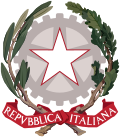National symbols of Italy
Appearance
| Part of a series on the |
| Culture of Italy |
|---|
 |
| People |
| Traditions |
National symbols of Italy are the symbols that are used in Italy to represent what is unique about the nation, reflecting different aspects of its cultural life and history.[1]
Symbols
| Symbol | Image | Remarks | Notes | |
|---|---|---|---|---|
| Flag | Flag of Italy |  |
Is a tricolour featuring three equally sized vertical pales of green, white, and red, with the green at the hoist side. Its current form has been in use since 19 June 1946 and was formally adopted on 1 January 1948. | [2] |
| Flag | Presidential flag |  |
Is the official standard based on the square flag of the Napoleonic Italian Republic, on a field of blue, charged with the coat of arms in gold. After the Republic was proclaimed, the national flag was provisionally adopted as distinguishing flag of the head of state in place of the royal standard. On the initiative of the Ministry of Defence, a project was prepared in 1965 to adopt a distinct flag. | [3] |
| Coat of arms | Emblem of Italy |  |
Was adopted by the newly formed Italian Republic on 5 May 1948. Although often referred to as a coat of arms (or stemma in Italian), it is technically an emblem as it was not designed to conform to traditional heraldic rules. | |
| Emblem | Stella d’Italia |  |
Is the most ancient identity symbol of the Italian land. In modern times it has been associated with the Italia Turrita (Towered Italy), the ancient allegorical representation of the Italian peninsula. | [4] |
| National anthem | Inno di Mameli |  |
It is best known among Italians as Fratelli d'Italia (Brothers of Italy), from its opening line. The words were written in the autumn of 1847 in Genoa, by the then 20-year-old student and patriot Goffredo Mameli, in a climate of popular struggle for unification and independence of Italy which foreshadowed the war against Austria. | |
| National aerobatic team | Frecce Tricolori |  |
Is the aerobatic demonstration team of the Italian Aeronautica Militare, based at Rivolto Air Force Base, in the north-eastern Italian region of Friuli Venezia Giulia, province of Udine. | |
| National Monument | Altare della Patria |  |
The Monumento Nazionale a Vittorio Emanuele II (National Monument to Victor Emmanuel II) or Altare della Patria (Altar of the Fatherland) or "Il Vittoriano" is a monument built to honour Victor Emmanuel, the first king of a unified Italy, located in Rome, Italy. | [5] |
See also
References
- ^ "England's National Symbols". england.org.za. Retrieved 18 September 2012.
National symbols are defined as the symbols or icons of a national community (such as England), used to represent that community in a way that unites its people.
- ^ Costituzione della Repubblica Italiana Art. 12, 22 dicembre 1947, pubblicata nella Gazzetta Ufficiale nº 298 del 27 dicembre 1947 edizione straordinaria (published in the Official Gazette [of the Italian Republic] No. 298 of the 27 December 1947 extraordinary edition) "La bandiera della Repubblica è il tricolore italiano: verde, bianco, e rosso, a tre bande verticali di eguali dimensioni"
- ^ "I SIMBOLI DELLA REPUBBLICA - LO STENDARDO".
- ^ "The Star of Italy and the Futurists". italianfuturism.org. Retrieved 18 September 2012.
- ^ "I SIMBOLI DELLA REPUBBLICA - IL VITTORIANO".
